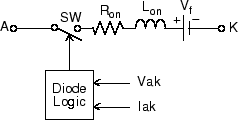Diode
(To be removed) Implement diode model
The Specialized Power Systems library will be removed in R2026a. Use the Simscape™ Electrical™ blocks and functions instead. For more information on updating your models, see Upgrade Specialized Power System Models to use Simscape Electrical Blocks.
Libraries:
Simscape /
Electrical /
Specialized Power Systems /
Power Electronics
Description
The diode is a semiconductor device that is controlled by its own voltage Vak and
current Iak. When a diode is forward biased (Vak > 0), it starts to conduct with a
small forward voltage Vf across it. It turns off when the current flow into the device
becomes 0. When the diode is reverse biased (Vak < 0), it stays in the off state.
The Diode block is simulated by a resistor, an inductor, and a DC voltage source connected in series with a switch. The switch operation is controlled by the voltage Vak and the current Iak.

The Diode block also contains a series Rs-Cs snubber circuit that can be connected in parallel with the diode device (between nodes A and K).
Assumptions and Limitations
The Diode block implements a macro model of a diode device. It does not take into account either the geometry of the device or the complex physical processes underlying the state change [1]. The leakage current in the blocking state and the reverse-recovery (negative) current are not considered. In most circuits, the reverse current does not affect converter or other device characteristics.
Depending on the value of the inductance Lon, the diode is modeled either as a current source (Lon > 0) or as a variable topology circuit (Lon = 0). The Diode block cannot be connected in series with an inductor, a current source, or an open circuit, unless its snubber circuit is in use.
The inductance Lon is forced to 0 if you choose to discretize your circuit.
Ports
Output
Conserving
Parameters
References
[1] Rajagopalan, V., Computer-Aided Analysis of Power Electronic Systems, Marcel Dekker, Inc., New York, 1987.
[2] Mohan, N., T.M. Undeland, and W.P. Robbins, Power Electronics: Converters, Applications, and Design, John Wiley & Sons, Inc., New York, 1995.
Extended Capabilities
Version History
Introduced before R2006a
